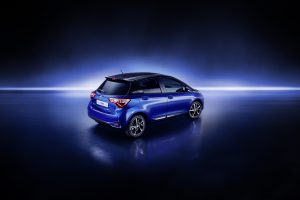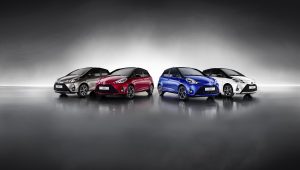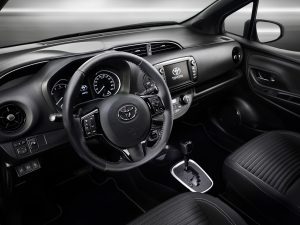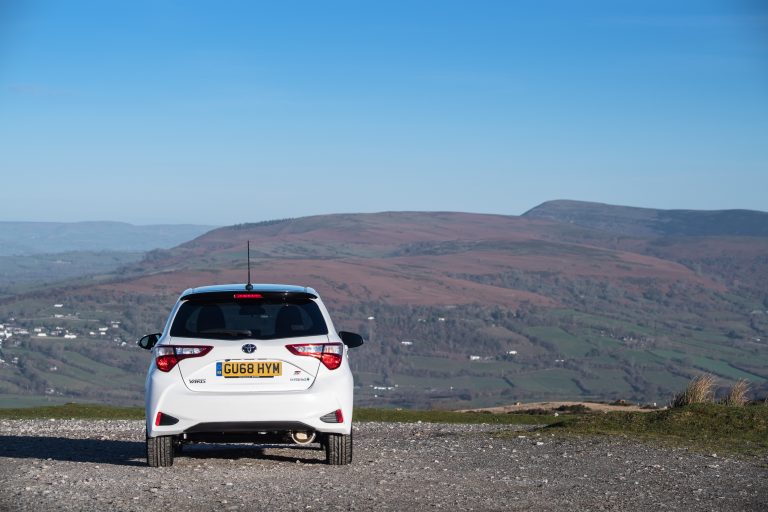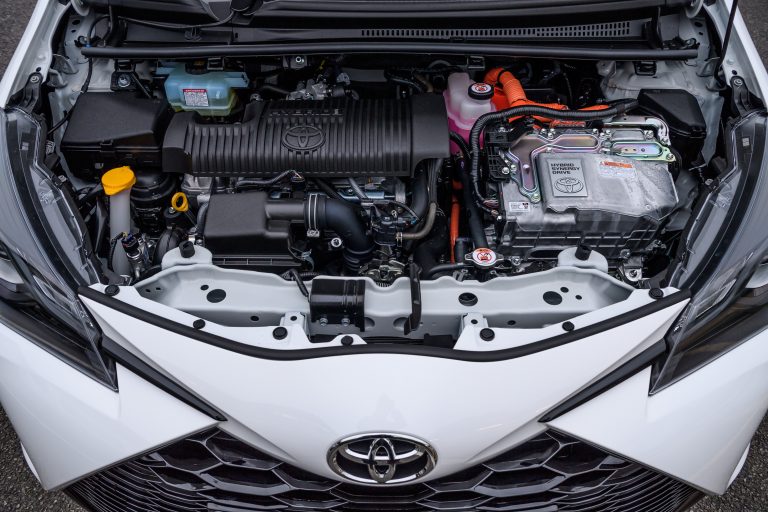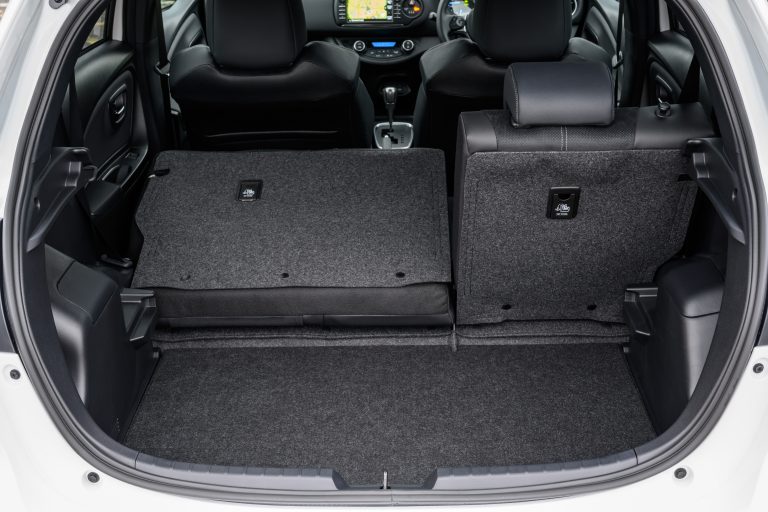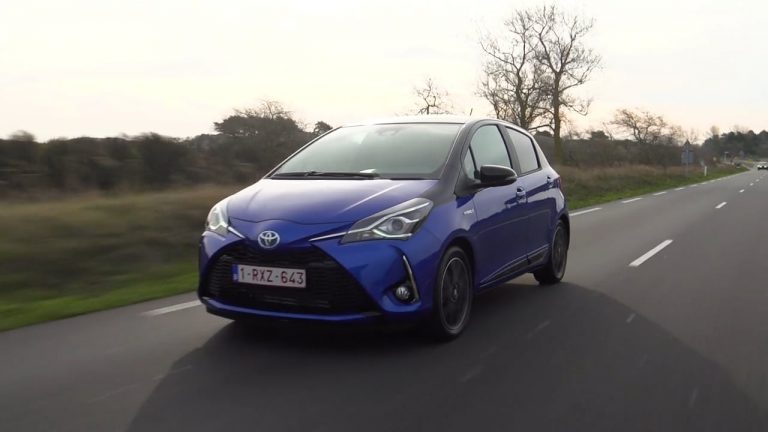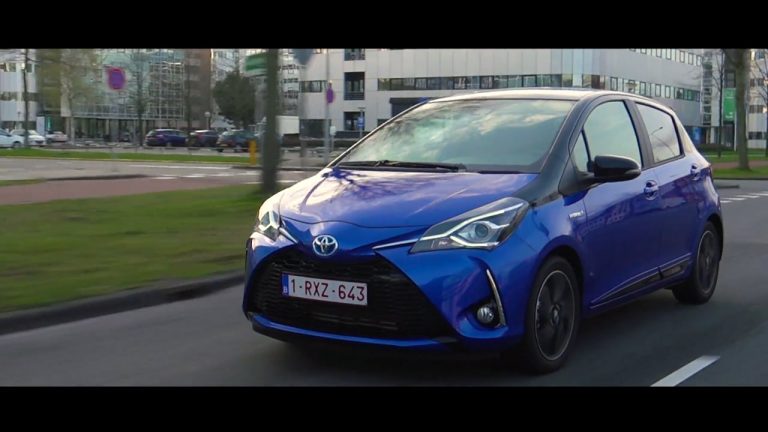New 2017 Toyota Yaris
Toyota has carried out a €90 million improvement programme to strengthen the success of Yaris, introducing new styling and equipment grades, enhancing handling and safety and introducing a new, highly efficient 1.5-litre petrol engine. Currently selling in record numbers, the new Yaris looks set to reach even greater heights.
The introduction of the new, significantly revised Yaris range is set to add to further impetus to the success of Toyota’s small hatchback. In fact, the car has continued to increase its share of the B-segment (supermini) market in Western Europe since the launch of the third generation of the model in 2011, rising to more than 6.5 per cent and 208,000-plus sales in the past year.
This performance provides a strong platform on which to strengthen Yaris’s established qualities and broaden its appeal to new and increasingly discerning customers in a highly competitive marketplace. Design, quality, performance and safety are key purchase considerations and have been the focus areas for Toyota’s programme of improvements.
Hybrid power remains a unique selling point for the model, a powertrain option that is currently leveraging more than 40 per cent of all Yaris’s European sales – almost 50 per cent in the UK.
Yaris has a strong European heritage, having been manufactured at Toyota Motor Manufacturing France’s Valenciennes factory since 2001. Production passed three million units in 2016, with cars not only supplied throughout Europe, but also sent for export around the world, including Africa, North America and Middle East markets in Asia.
A global project, led by Europe
Toyota has handed much of the responsibility for shaping the new Yaris to its European operations, reflecting the strength and quality of the B-segment market in the region. Notably, this is the first time that changes developed for the Yaris in Europe will be adopted directly for its sister Vitz model, manufactured in Japan.
Going much deeper than a simple mid-life “facelift,” the €90 million programme sees the introduction of more than 900 new parts to improve the car’s design, dynamic performance and safety. The car’s new look, with significant changes to the front and rear styling, has been created at Toyota’s ED2 design studio in the South of France,
Exterior design
Design is a key consideration for supermini customers and the team at ED2 has focused on giving the new Yaris a more active and dynamic look while at the same time communicating a more refined direction. To achieve this, both the front and rear of the car have been given a new design architecture that presents a stronger three-dimensional quality, a greater emphasis on horizontal lines to express a wide stance and low centre of gravity.
The result is a more dynamic and emotional shape that amplifies the qualities of Toyota’s contemporary design principles.
The redesign of the front of the car features a new front bumper that creates a “catamaran” shape with broad sections flowing down from new headlight units, flanking the wide, trapezoidal grille. The result is a more pronounced three-dimensional effect, and the sense of a wider, more planted road stance. A simplified design in the area around the central Toyota emblem adds to the overall dynamic impact.
The grille itself benefits from new treatments that contribute to the new Yaris’s more resolute look, with a honeycomb design for Bi-tone grades and arrangement of “stepped” horizontal bars for other grades that again delivers a more eye-catching, 3D effect. The integrated fog light housings either side of the grille have also been reworked with a more compact recess and a vertical line that arcs smoothly to follow the outer edge of the bumper – featuring a bright chrome trim detail on higher grade versions.
New headlight designs
The new headlamp units further develop the impact of the frontal design, producing a new, individual lighting signature. Where LED daytime running lights are fitted, light guides create a forked frame around the main lamp that flows seamlessly into a single line; this line extends beyond the projector headlamp in a matching chrome trim element that extends towards the central Toyota emblem on the bonnet. This is available on higher grade models, while on mid-range versions the distinctive forked pattern is created using slim chrome trim bars within the headlamp unit.
Dynamic profile view
The new Yaris’s side view helps generate added dynamism with more emphasis given to the axis line of the body from front to rear. Here, the new tailgate and rear light units contribute to the sense of extra length and tautness in the car’s profile. There is also a new lower door moulding which adds a sportier look by leading the eye neatly into the line of the new rear lamp cluster, finished in piano black or chrome, according to model grade.
The range of wheels includes three new designs available for different grade models: a 15-inch silver wheel cover, a multi-spoke 15-inch alloy and a new 16-inch wheel with a machined face finish.
Revised rear design with new tailgate, bumper and lamp clusters
At the rear the added sense of refinement is reflected in a stronger central mass, created by a new tailgate design that strengthens the horizontal emphasis with new rear light clusters that extend from the rear wings onto the door itself. According to model grade, the rear lights feature LED stop and tail lights with light guides, asserting the new Yaris’s premium quality and, like the front lights, presenting a distinctive illumination signature.
Following the same concept as new the frontal design, a “catamaran” architecture has been created at the rear of the car with a new bumper design that harmonises perfectly with the lines of the tailgate, projecting the sense of a low centre of gravity and wide on-road stance. The powerful quality of this design is supported by a re-shaping of the area framing the licence plate and the addition of black garnish details in the lower bumper, edged with reflectors and finished with a pattern of straked, horizontal lines.
Two new colours have been added to the range of paint finishes – Hydro Blue and Tokyo Red, taking the total to 10 different shades.
Interior design
The focus for changes to Yaris’s interior was to keep the look and ambience of the cabin feeling fresh and modern, introducing new upholsteries, colours and trim details and upgrading the instrumentation and controls to ensure excellent ergonomics and HMI (human-machine interface) performance.
The combimeter in the driver’s instrument binnacle has a new “binocular” arrangement of twin analogue dials flanking a new 4.2-inch colour TFT multi-information display, fitted as standard from mid-range trim. Different information and vehicle data can be selected and adjusted using control switches on the three-spoke steering wheel, which itself has a new look with the addition of piano black trim inserts (mid-range and higher). A new chrome trim frames the combimeter, adding to the more refined effect.
Other detail changes include new propeller-style air vents, cool blue instrument illumination and a more streamlined, seamless execution of the multimedia screen and controls in the centre console, including new switches that are both neater in appearance and easier to use.
New upholsteries, trims and colour options
The new Yaris offers customers more choice in terms of interior finish, with co-ordinated upholstery and trim colour options that harmonise the cabin’s appearance.
The entry level model combines a grey instrument panel insert with new black cloth upholstery with a distinctive houndstooth check design for the centre seatback and cushion. For mid-range models the cloth has a smart black/grey gradation pattern and the instrument panel insert and upper door trims are in a toning dark grey with a soft-touch finish and animal grain pattern. On higher grade models the same upholstery is used, with a black instrument panel and door trim.
For Bi-tone versions of the new Yaris, there is a dedicated interior treatment for each exterior colour choice: blue with blue/black, burgundy with red/black, warm grey with bronze/black and black with white/black. The colour detailing covers the instrument panel insert and door trims, plus inserts in the seatbacks and edging to the seatback and cushion bolsters.
Improved hybrid powertrain performance
Yaris remains unique in the B-segment in giving customers the option of hybrid power and the chance to experience the smooth, relaxed and intuitive drive Toyota’s world-leading technology provides, together with excellent fuel economy and best-in-class exhaust emissions (from 75g/km CO2). In developing the new Yaris, Toyota engineers listened to customer feedback to understand where improvements might be made to achieve an even quieter and more comfortable ride with better handling and steering accuracy.
Revealing the real benefits of hybrid driving
Toyota is deploying a smart data-gathering tool to help European retailers demonstrate to customers how hybrid technology works and the real benefits it can deliver.
The Driveco box is already being used in seven European markets for hybrid models including Yaris Hybrid and is set for pilot trials in nine more. An automatic driver log system, it collects data on test drive journey distances, times and average speeds, plus the proportion of the journey in which car operates in all-electric EV mode, with zero fuel consumption and zero tailpipe emissions. The information can be downloaded and viewed using a smartphone or tablet app, along with comparisons with previous performance, and with the levels achieved by other drivers.
Driveco has already logged data from 900 Yaris Hybrids and more than half a million kilometres of driving in all kinds of environments, from city centres to mountain routes. The combined results reveal that together the cars have operated in EV mode for more than 54% of the time, achieving real-world average fuel consumption of 56.5mpg.
An even quieter drive
Although Toyota hybrids are noted for their quiet performance, new Yaris’ engineers undertook a thorough review to ascertain where improvements in noise and vibration levels could be made, in particular to reduce any noise intrusion from the powertrain under acceleration.
As a result, a comprehensive range of measures has been introduced, including the installation of redesigned engine mounts, a larger engine roll restrictor, new front driveshafts and front subframe and a modified air box intake system. Additionally, the exhaust system has been adjusted with a new sub-silencer.
Ride comfort and handling
The new engine mount design also helps the new Yaris Hybrid deliver a more comfortable ride, with less vehicle shake caused by engine movement when driving over uneven surfaces. Changes have also been made to the shock absorbers’ damping force and valve design to enhance comfort while maintaining handling performance.
The electric power steering has been tuned for less friction feel and smoother response to driver inputs. Cornering traceability has been improved by more closely aligning the driver’s steering effort with the vehicle’s response.
New 1.5-litre petrol engine
The new Yaris marks the introduction of a new 1.5-litre four-cylinder petrol engine to the range to replace the current 1.33-litre unit, developed in anticipation of future Euro 6c emissions standard and RDE (Real Driving Emission) homologation requirements. It is being manufactured by Toyota Motor Industries Poland as part of a €150 million production investment programme by Toyota Motor Europe.
The engine is a member of Toyota’s ESTEC (Economy with Superior Thermal Efficiency) family, benefiting from new technical features that deliver better performance and a more enjoyable drive, while at the same time achieving a reduction of up to 12 per cent* in fuel consumption, using the current NEDC test parameters.
In the new Yaris the naturally aspirated 1,496cc engine develops a maximum 110bhp/82kW and peak torque of 136Nm at 4,400rpm. Its responsiveness ensures a comfortable drive both in urban traffic and on the open road. Compared to the 1.33-litre unit, it is 0.8 seconds quicker in acceleration from 0 to 62mph (11.0 versus 11.8), while at overtaking speed in fifth gear the improvement is more than a second, moving from 50 to 75mph in 17.6 seconds compared to 18.8.
Toyota’s world-leading experience in hybrid powertrain technology has proved valuable in addressing the challenges presented by the new Euro 6c emissions standard and RDE homologation cycle, witnessed in the new engine achieving a 38.5 per cent thermal efficiency value, placing it among the best on the market. This has been achieved by using a high, 13.5:1 compression ratio, adopting a cooled exhaust gas recirculation (EGR) system and extending the variable valve timing operation so that the engine can switch from the Otto to the Atkinson cycle to gain optimum efficiency in different driving conditions.
The higher compression ratio has been made possible by the combustion chamber design and new pistons, which promote a homogenous air/petrol mixture and rapid combustion. Cooled EGR reduces combustion temperature and also helps prevent engine knocking. Furthermore, the volume of reinjected inert gases allows for a reduction in pumping losses at low and medium loads, improving overall engine efficiency.
The adoption of a new variable inlet valve timing system – VVT-iE** – allows the engine to switch from the Otto to the Atkinson cycle (and vice-versa) in a fraction of a second. Controlled electronically, closure of the intake valve is delayed, reducing the compression phase and further helping reduce pumping losses (Atkinson cycle), and enabling a prompt return to the Otto cycle for better performance under high loads The phase shift of the exhaust camshaft is hydraulically controlled.
The engineers also focused on improving fuel consumption at sustained motorway cruising speeds, leading to the use – for the first time on a Toyota – of a water-cooled exhaust manifold. By limiting the gas temperature, this avoids the need for mixture enrichment to reduce combustion temperature at any motorway driving speed. As a result, both fuel consumption and exhaust emissions are reduced.
In common with other Toyota ESTEC engines, the 1.5-litre unit benefits from the latest measures designed to reduce friction losses.
*with CVT
** Variable Valve Timing – intelligent Electric Motor
Toyota Safety Sense as standard
Toyota puts safety at the heart of its commitment to building ever-better cars, ensuring that the benefits of advanced technologies are not limited to high-end, high-specification models, but are made available across the board. True to this ethos, it has made Toyota Safety Sense a standard feature on all new Yaris models.
This ensures that every car in the line-up is equipped with systems that can help prevent an accident happening, or lessen the consequences if an impact does occur. The package includes a Pre-Collision System with Autonomous Emergency Braking, Automatic High Beam, Lane Departure Alert and, on models higher than Entry grade, Road Sign Assist.
The pre-collision system uses a front-mounted laser to monitor the road ahead, warning the driver of an imminent collision risk and preparing the brakes to deliver emergency braking the moment the brake pedal is pressed. If the driver fails to respond to the warning, the system will trigger Autonomous Emergency Braking to slow the car to reduce the severity of any impact.
Automatic High Beam detects both the headlights of oncoming traffic and the tail lights of vehicles ahead, automatically switching between low and high beam to avoid dazzling other drivers, while maintaining the best possible illumination for night-time driving.
The Lane Departure Alert monitors lane markings on the road surface and helps prevent accidents caused by the vehicle moving out of its lane. If the Yaris begins to deviate from its lane without the turn indicators being used, the system alerts the driver visual and audible warnings.
Road Sign Assist helps ensure drivers are kept informed about key road warnings and commands, even if they have driven past a road sign without noticing it. The system recognises signs such as speed limits and “no overtaking” restrictions and presents them on the colour TFT multi-information display in the driver’s combimeter. If the driver exceeds the speed limit, the system will activate a warning light and buzzer.
To improve safety for people on board, the rear seatbelts now feature force limiters and pretensioners. The head restraints have been redesigned to provide better protection against whiplash injury and the shape of the curtain airbags has been revised. Child seat installation has been made easier with adjustments to the Isofix anchoring system and labelling.
*Road Sign Assist not available on Entry grade
Note to editors: details of UK market grades, equipment, specifications and prices will be announced after the 2017 Geneva motor show.


